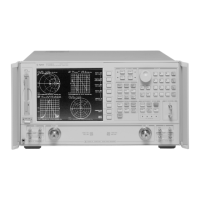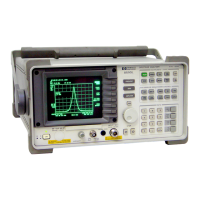5-12
Optimizing Measurement Results
Increasing Sweep Speed
If you must view both measurement channels simultaneously (with dual channel), use the chop sweep
mode, explained next.
3. If you want to view channel 3 (or channel 4), press (or ). This will always result in a
dual trace display of channel 1 and channel 3 (or channel 2 and channel 4).
To return to a single-trace display, press
.
To Activate Chop Sweep Mode
You can use the chop sweep mode to make two measurements at the same time. For example, the analyzer
can measure S11 and S21 simultaneously. You can activate the chop mode by pressing
or by
pressing .
While Chop mode is the fastest way to measure devices, some components, such as filters with very high
attenuation, may require measurement in Alternate mode. See
"Increasing Dynamic Range" on page 5-14.
To Use External Calibration
Off-loading the error correction process to an external PC increases throughput on the network analyzer.
This can be accomplished with remote-only commands. Refer to the programmer's guide for information on
how to use external calibration.
To Use Fast 2-Port Calibration (ES Analyzers Only)
With a 2-port calibration on, faster trace updates are possible by not measuring the reverse path for every
forward sweep. This is controlled by the test set switch command. This is convenient for tuning applications
because it gives a faster trace update.
When making measurements using full two-port error-correction, the following types of test set switching
can be defined by the user:
• Hold: In this mode the analyzer does not switch between the test ports on every sweep. The
measurement stays on the active port after an initial cycling between the ports. The fastest
measurements can be made by using this type of test set switching. Pressing the
key, changing
to a different S-parameter measurement, or any other action which restarts a sweep will cause the test
set to switch and cycle between the ports.

